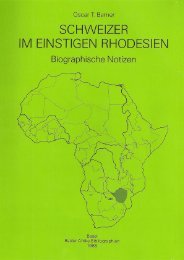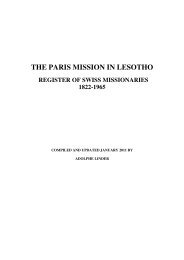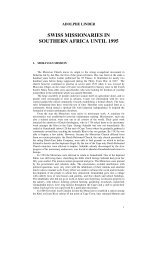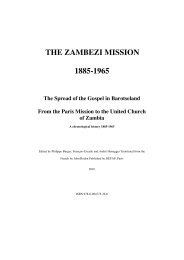THE SWISS IN SOUTHERN AFRICA 1652-1970 - swissroots-za.ch
THE SWISS IN SOUTHERN AFRICA 1652-1970 - swissroots-za.ch
THE SWISS IN SOUTHERN AFRICA 1652-1970 - swissroots-za.ch
You also want an ePaper? Increase the reach of your titles
YUMPU automatically turns print PDFs into web optimized ePapers that Google loves.
general reader. The following comparisons with English and German spelling might<br />
suffice.<br />
TABLE 1<br />
Dut<strong>ch</strong> phonetics<br />
Dut<strong>ch</strong> English equivalent German equivalent<br />
a a as in last a as in Last<br />
e e as in den e as in denn<br />
g <strong>ch</strong> as in lo<strong>ch</strong> <strong>ch</strong> as in Lo<strong>ch</strong><br />
j y as in yes j as in ja<br />
ng ng as in sing in as in singen<br />
o at end of word or syllable o as in do u as in gut<br />
oe, oo ou as in you u as in du<br />
ou ow as in low ou as written<br />
s<strong>ch</strong> s<strong>ch</strong> as in s<strong>ch</strong>ool sk as in Skizze<br />
sj sh as in show s<strong>ch</strong> as in S<strong>ch</strong>au<br />
u u as in the Fren<strong>ch</strong> word du ü as in Tür<br />
ui, uy oi as in loins eu as in Reue<br />
v f as in fat f as in Fass<br />
w v as in vat w as in was<br />
y ay as in tray ei as in Ei<br />
Very often names would be distorted by usage to adapt to the Dut<strong>ch</strong> tongue.<br />
Examples are Loubser and Losber for Laubs<strong>ch</strong>er, Yselle for Iseli and Hongerbuydel for<br />
Hungerbüller.<br />
3.2 Swiss Origins of Arrivals<br />
It is appropriate to mention at the outset that ea<strong>ch</strong> Swiss is the citizen of a particular<br />
commune (village or town) and that he inherits this citizenship from his father<br />
irrerspective of where he was born. Thus a family might live for generations anywhere<br />
else, yet remain citizens of the commune of origin. Until the beginning of the nineteenth<br />
century nearly all families still lived at their place of origin, then industrialisation<br />
caused increasing population movements. An example is the wat<strong>ch</strong> industry whi<strong>ch</strong><br />
developed in the Jura attracting many families from, for example, the Bernese Oberland.<br />
Since the beginning of this century the place of birth of Swiss increasingly differs from<br />
their place of origin. Where both are known, the latter will be shown in brackets.<br />
The system of passing citizenship from father to <strong>ch</strong>ildren born in wedlock resulted in<br />
ana<strong>ch</strong>ronisms. The <strong>ch</strong>ildren of a Swiss man and his non-Swiss wife, who were born and<br />
raised in a foreign country, would be registered as Swiss, whereas when a Swiss woman<br />
married a Non-Swiss, even though he may have been born and raised in Switzerland,<br />
lost her Swiss citizenship and both she and her <strong>ch</strong>ildren were assigned the nationality of<br />
her husband. In this work we have treated all individuals born in Switzerland as Swiss.<br />
Ea<strong>ch</strong> commune in Switzerland keeps a register of its citizens. When a man marries, a<br />
new page is opened for him and his family. This system greatly facilitates genealogical<br />
resear<strong>ch</strong> when the records are accessible.<br />
The Familiennamenbu<strong>ch</strong> der S<strong>ch</strong>weiz lists all Swiss surnames both extinct and extant,<br />
citing when and in whi<strong>ch</strong> communes they had received citizenship rights. Extensive but<br />
cautious use was made of this book to <strong>ch</strong>eck or even determine the origin of Swiss<br />
where this was not recorded at the Cape. In special cases civil registrars were asked for<br />
verification and this was often kindly supplied together with additional information, as<br />
in the case of Gabriel Jenny of Ennenda GL, “The Major who turned Farm Labourer”.<br />
Information obtained by these means is shown between square brackets.<br />
Another point to be remembered is that cantonal boundaries were only given their<br />
present shape in 1803. Before that date the Vaud was part of Canton Berne, Aargau<br />
belonged to Cantons Berne and Zuri<strong>ch</strong>, Thurgau was part of Canton Zuri<strong>ch</strong> and Canton<br />
St. Gall had not yet been formed. Men from Vaud would for instance name (Canton)<br />
7







